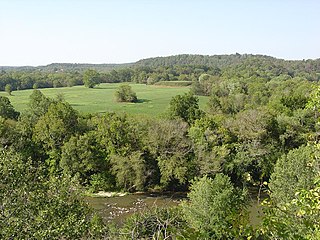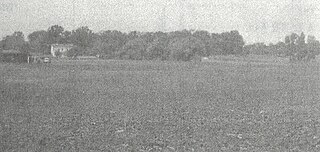Related Research Articles

The Mississippian culture was a Native American civilization that flourished in what is now the Midwestern, Eastern, and Southeastern United States from approximately 800 CE to 1600 CE, varying regionally. It was known for building large, earthen platform mounds, and often other shaped mounds as well. It was composed of a series of urban settlements and satellite villages linked together by loose trading networks. The largest city was Cahokia, believed to be a major religious center located in what is present-day southern Illinois.

Spiro Mounds is an archaeological site located in present-day eastern Oklahoma that remains from an indigenous Indian culture that was part of the major northern Caddoan Mississippian culture. The 80-acre site is located within a floodplain on the southern side of the Arkansas River. The modern town of Spiro developed approximately seven miles to the south.

The Grand Village of the Illinois, also called Old Kaskaskia Village, is a site significant for being the best documented historic Native American village in the Illinois River valley. It was a large agricultural and trading village of Native Americans of the Illinois confederacy, located on the north bank of the Illinois River near the present town of Utica, Illinois. French explorers Louis Joliet and Father Jacques Marquette came across it in 1673. The Kaskaskia, a tribe of the Illiniwek people lived in the village. It grew rapidly after a French mission and fur trading post were established there in 1675, to a population of about 6,000 people in about 460 houses. Around 1691 the Kaskaskia and other Illiniwek moved further south, abandoning the site due to pressure from an Iroquois invasion from the northeast.
The Orendorf Site is a prehistoric archaeological site located near the city of Canton, Fulton County, Illinois. The site includes four distinct areas of Middle Mississippian settlement; the settlement area was one of seven major sites in the Spoon River tradition. The four settlement sites within the larger site came as the result of a single village relocating multiple times; this movement became useful to archaeologists, as artifacts from different periods are spread out rather than mixed together at a single site. The settlement functioned as a regional center within the Spoon River culture, making it a hub in its hierarchal political organization and part of many important trade routes. Trade and migration linked the settlement to the large Mississippian city of Cahokia; while the settlement's culture had much in common with Cahokian culture, it was also a distinct regional culture in its own right.

Mound Bottom is a prehistoric Native American complex in Cheatham County, Tennessee, located in the Southeastern United States. The complex, which consists of earthen platform and burial mounds, a 7-acre central plaza, and habitation areas, was occupied between approximately 1000 and 1300 AD, during the Mississippian period.

The archaeology of Iowa is the study of the buried remains of human culture within the U.S. state of Iowa from the earliest prehistoric through the late historic periods. When the American Indians first arrived in what is now Iowa more than 13,000 years ago, they were hunters and gatherers living in a Pleistocene glacial landscape. By the time European explorers visited Iowa, American Indians were largely settled farmers with complex economic, social, and political systems. This transformation happened gradually. During the Archaic period American Indians adapted to local environments and ecosystems, slowly becoming more sedentary as populations increased. More than 3,000 years ago, during the Late Archaic period, American Indians in Iowa began utilizing domesticated plants. The subsequent Woodland period saw an increase on the reliance on agriculture and social complexity, with increased use of mounds, ceramics, and specialized subsistence. During the Late Prehistoric period increased use of maize and social changes led to social flourishing and nucleated settlements. The arrival of European trade goods and diseases in the Protohistoric period led to dramatic population shifts and economic and social upheaval, with the arrival of new tribes and early European explorers and traders. During the Historical period European traders and American Indians in Iowa gave way to American settlers and Iowa was transformed into an agricultural state.

The Upper Mississippian cultures were located in the Upper Mississippi basin and Great Lakes region of the American Midwest. They were in existence from approximately A.D. 1000 until the Protohistoric and early Historic periods.

The Kansas City Hopewell were the farthest west regional variation of the Hopewell tradition of the Middle Woodland period. Sites were located in Kansas and Missouri around the mouth of the Kansas River where it enters the Missouri River. There are 30 recorded Kansas City Hopewell sites.
The Cloverdale archaeological site (23BN2) is an archaeological site located near present-day St. Joseph, Missouri. It is situated at the mouth of a small valley that opens into the Missouri River.

Long-nosed god maskettes are artifacts made from bone, copper and marine shells associated with the Mississippian culture and found in archaeological sites in the American Midwest and Southeast. They are small shield-shaped faces with squared-off foreheads, circular eyes, and large noses of various lengths. They are often shown on Southeastern Ceremonial Complex representations of falcon impersonators as ear ornaments. Long and short nosed versions of the masks have been found in ten different states, with the majority found at sites in Illinois. Many archaeologists now associate them with the Ho-Chunk (Winnebago) stories of the mythological being Red Horn.
The Griesmer site (La-3) is located on the Kankakee River in Lake County, Indiana, about a mile southeast of Schneider, in Northwestern Indiana. It is classified as a Prehistoric, multi-component site with Middle Woodland, Late Woodland and Upper Mississippian occupations. The deposits were not stratified, but observation of the types of artifacts present, together with radiocarbon dates, helped to define the sequence of occupations at the site.
The Huber Site (11Ck-1) is located on Tinley Creek 2 miles west of Blue Island in Cook County, Illinois, near the city of Chicago. It is classified as a late prehistoric site with Upper Mississippian affiliation.
The Hoxie Farm site (11Ck-4) is located on Thorn Creek in Thornton, Illinois Cook County Forest Preserve in Cook County, Illinois, near the city of Chicago. It is classified as a late prehistoric to Protohistoric/Early Historic site with Upper Mississippian Huber affiliation.

The Knoll Spring site (11Ck-19), aka Au Sagaunashke village, is located in the Sag Valley, Palos Hills, in Cook County, Illinois, near the city of Chicago. It is classified as a late prehistoric site with Upper Mississippian Huber affiliation.
The Oak Forest Site (11Ck-53) is located in Oak Forest, Cook County, Illinois, near the city of Chicago. It is classified as a late prehistoric to Protohistoric/Early Historic site with Upper Mississippian Huber affiliation.
The Anker Site (11Ck-21) is located on the Little Calumet River near Chicago, Illinois. It is classified as a late prehistoric site with Upper Mississippian Huber affiliation.
The Gentleman Farm site is located in LaSalle County, Illinois, on the Illinois River. It is a multi-component site with the main occupation being a Langford tradition component of Upper Mississippian affiliation.
The Fisher Mound Group is a group of burial mounds with an associated village site located on the DesPlaines River near its convergence with the Kankakee River where they combine to form the Illinois River, in Will County, Illinois, about 60 miles southwest of Chicago. It is a multi-component stratified site representing several Prehistoric Upper Mississippian occupations as well as minor Late Woodland and Early Historic components.

The Upper Iowa River Oneota site complex is a series of 7 Iowa archaeological sites located within a few miles of each other in Allamakee County, Iowa, on or near the Upper Iowa River. They are all affiliated with the Late Prehistoric Upper Mississippian Oneota Orr focus. In some cases there are early European trade goods present, indicating occupation continued into the Protohistoric or early Historic period.
The Midway Site (47LC19) is a prehistoric Upper Mississippian Oneota site in La Crosse County, Wisconsin. It is located about 10 miles north of LaCrosse near the juncture of the Black and Mississippi Rivers.
References
- Logan, Brad. "Archaeological Investigations at the Evans Locality Stranger Creek Valley, Northeastern Kansas-2003" Department of Sociology, Anthropology, and Social Work. Kansas State University, Manhattan, 2003.
- O’Brien, Patricia J. "Steed-Kisker: A Western Mississippian Settlement System." In, Mississippian Settlement Patterns, edited by Bruce D. Smith, pp. 1–19, 1978. Academic Press, New York.
- O'Brien, Patricia J. "Steed-Kisker: A Cultural Interpretation." The Missouri Archaeologist 42: 96–108, 1981.
- O'Brien, Patricia J. "Ancient Kansas City Area Borders and Trails." The Missouri Archaeologist 49: 27–39, 1988.
- O'Brien, Patricia J. "Steed-Kisker: The Western Periphery of the Mississippian Tradition.: Midcontinental Journal of Archaeology 18 (1): 281-283, 1993.
- Roper, Donna. "Central Plains Tradition" In Kansas Archaeology, edited by Robert J. Hoard and William E. Banks, pp. 105–132, 2006. University Press of Kansas, Lawrence.
- Wedel, Waldo R. "Archaeological Investigations in Platte and Clay Counties, Missouri." Smithsonian Institution, United States National Museum Bulletin 183. Washington D.C.: Smithsonian Institution, 1943.
